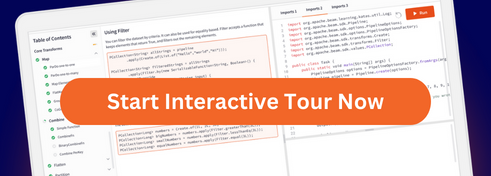Nexmark benchmark suite
What it is
Nexmark is a suite of pipelines inspired by the ‘continuous data stream’ queries in Nexmark research paper
These are multiple queries over a three entities model representing on online auction system:
- Person represents a person submitting an item for auction and/or making a bid on an auction.
- Auction represents an item under auction.
- Bid represents a bid for an item under auction.
The queries
The queries exercise many aspects of Beam model:
- Query1 or CURRENCY_CONVERSION: What are the bid values in Euro’s? Illustrates a simple map.
- Query2 or SELECTION: What are the auctions with particular auction numbers? Illustrates a simple filter.
- Query3 or LOCAL_ITEM_SUGGESTION: Who is selling in particular US states? Illustrates an incremental join (using per-key state and timer) and filter.
- Query4 or AVERAGE_PRICE_FOR_CATEGORY: What is the average selling price for each auction category? Illustrates complex join (using custom window functions) and aggregation.
- Query5 or HOT_ITEMS: Which auctions have seen the most bids in the last period? Illustrates sliding windows and combiners.
- Query6 or AVERAGE_SELLING_PRICE_BY_SELLER: What is the average selling price per seller for their last 10 closed auctions. Shares the same ‘winning bids’ core as for Query4, and illustrates a specialized combiner.
- Query7 or HIGHEST_BID: What are the highest bids per period? Deliberately implemented using a side input to illustrate fanout.
- Query8 or MONITOR_NEW_USERS: Who has entered the system and created an auction in the last period? Illustrates a simple join.
We have augmented the original queries with five more:
- Query0 or PASSTHROUGH: Pass-through. Allows us to measure the monitoring overhead.
- Query9 or WINNING_BIDS: Winning-bids. A common sub-query shared by Query4 and Query6.
- Query10 or LOG_TO_SHARDED_FILES: Log all events to GCS files. Illustrates windows with large side effects on firing.
- Query11 or USER_SESSIONS: How many bids did a user make in each session they were active? Illustrates session windows.
- Query12 or PROCESSING_TIME_WINDOWS: How many bids does a user make within a fixed processing time limit? Illustrates working in processing time in the Global window, as compared with event time in non-Global windows for all the other queries.
- BOUNDED_SIDE_INPUT_JOIN: Joins a stream to a bounded side input, modeling basic stream enrichment.
Benchmark workload configuration
Here are some of the knobs of the benchmark workload (see NexmarkConfiguration.java).
These configuration items can be passed to the launch command line.
Events generation (defaults)
- 100 000 events generated
- 100 generator threads
- Event rate in SIN curve
- Initial event rate of 10 000
- Event rate step of 10 000
- 100 concurrent auctions
- 1000 concurrent persons bidding / creating auctions
Windows (defaults)
- size 10s
- sliding period 5s
- watermark hold for 0s
Events Proportions (defaults)
- Hot Auctions = ½
- Hot Bidders =¼
- Hot Sellers=¼
Technical
- Artificial CPU load
- Artificial IO load
Nexmark output
Here is an example output of the Nexmark benchmark run in streaming mode with the SMOKE suite on the (local) direct runner:
Performance: Conf Runtime(sec) Events(/sec) Results 0000 5,5 18138,9 100000 0001 4,2 23657,4 92000 0002 2,2 45683,0 351 0003 3,9 25348,5 444 0004 1,6 6207,3 40 0005 5,0 20173,5 12 0006 0,9 11376,6 401 0007 121,4 823,5 1 0008 2,5 40273,9 6000 0009 0,9 10695,2 298 0010 4,0 25025,0 1 0011 4,4 22655,2 1919 0012 3,5 28208,7 1919
Benchmark launch configuration
The Nexmark launcher accepts the --runner argument as usual for programs that
use Beam PipelineOptions to manage their command line arguments. In addition
to this, the necessary dependencies must be configured.
When running via Gradle, the following two parameters control the execution:
-P nexmark.args
The command line to pass to the Nexmark main program.
-P nexmark.runner
The Gradle project name of the runner, such as ":runners:direct-java" or
":runners:flink:1.13. The project names can be found in the root
`settings.gradle.kts`.
Test data is deterministically synthesized on demand. The test data may be synthesized in the same pipeline as the query itself, or may be published to Pub/Sub or Kafka.
The query results may be:
- Published to Pub/Sub or Kafka.
- Written to text files as plain text.
- Written to text files using an Avro encoding.
- Sent to BigQuery.
- Discarded.
Common configuration parameters
Decide if batch or streaming:
--streaming=true
Number of events generators:
--numEventGenerators=4
Queries can be run by their name or by their number (number is still there for backward compatibility, only the queries 0 to 12 have a number)
Run query N:
--query=N
Run query called PASSTHROUGH:
--query=PASSTHROUGH
Available Suites
The suite to run can be chosen using this configuration parameter:
--suite=SUITE
Available suites are:
- DEFAULT: Test default configuration with query 0.
- SMOKE: Run all the queries with the default configuration.
- STRESS: Like smoke but for 1m events.
- FULL_THROTTLE: Like SMOKE but 100m events.
Google Cloud Dataflow runner specific configuration
--manageResources=false --monitorJobs=true \
--enforceEncodability=false --enforceImmutability=false
--project=<your project> \
--zone=<your zone> \
--workerMachineType=n1-highmem-8 \
--stagingLocation=gs://<a gs path for staging> \
--runner=DataflowRunner \
--tempLocation=gs://<a gs path for temporary files> \
--filesToStage=target/beam-sdks-java-nexmark-2.70.0.jar
Direct runner specific configuration
--manageResources=false --monitorJobs=true \
--enforceEncodability=false --enforceImmutability=false
Flink runner specific configuration
--manageResources=false --monitorJobs=true \
--flinkMaster=[local] --parallelism=#numcores
Spark runner specific configuration
--manageResources=false --monitorJobs=true \
--sparkMaster=local \
-Dspark.ui.enabled=false -DSPARK_LOCAL_IP=localhost -Dsun.io.serialization.extendedDebugInfo=true
Kafka source/sink configuration parameters
Set Kafka host/ip (for example, “localhost:9092”):
--bootstrapServers=<kafka host/ip>
Write results into Kafka topic:
--sinkType=KAFKA
Set topic name which will be used for benchmark results:
--kafkaResultsTopic=<topic name>
Write or/and read events into/from Kafka topic:
--sourceType=KAFKA
Set topic name which will be used for benchmark events:
--kafkaTopic=<topic name>
Current status
These tables contain statuses of the queries runs in the different runners. Google Cloud Dataflow status is yet to come.
Batch / Synthetic / Local
| Query | Direct | Spark | Flink |
|---|---|---|---|
| 0 | ok | ok | ok |
| 1 | ok | ok | ok |
| 2 | ok | ok | ok |
| 3 | ok | ok | ok |
| 4 | ok | ok | ok |
| 5 | ok | ok | ok |
| 6 | ok | ok | ok |
| 7 | ok | ok | ok |
| 8 | ok | ok | ok |
| 9 | ok | ok | ok |
| 10 | ok | ok | ok |
| 11 | ok | ok | ok |
| 12 | ok | ok | ok |
| BOUNDED_SIDE_INPUT_JOIN | ok | ok | ok |
Streaming / Synthetic / Local
| Query | Direct | Spark Issue 18416 | Flink |
|---|---|---|---|
| 0 | ok | ok | ok |
| 1 | ok | ok | ok |
| 2 | ok | ok | ok |
| 3 | ok | Issue 18074, BEAM-3961 | ok |
| 4 | ok | ok | ok |
| 5 | ok | ok | ok |
| 6 | ok | ok | ok |
| 7 | ok | BEAM-2112 | ok |
| 8 | ok | ok | ok |
| 9 | ok | ok | ok |
| 10 | ok | ok | ok |
| 11 | ok | ok | ok |
| 12 | ok | ok | ok |
| BOUNDED_SIDE_INPUT_JOIN | ok | BEAM-2112 | ok |
Batch / Synthetic / Cluster
Yet to come
Streaming / Synthetic / Cluster
Yet to come
Running Nexmark
Running SMOKE suite on the DirectRunner (local)
The DirectRunner is default, so it is not required to pass -Pnexmark.runner.
Here we do it for maximum clarity.
The direct runner does not have separate batch and streaming modes, but the Nexmark launch does.
These parameters leave on many of the DirectRunner’s extra safety checks so the SMOKE suite can make sure there is nothing broken in the Nexmark suite.
Batch Mode:
./gradlew :sdks:java:testing:nexmark:run \
-Pnexmark.runner=":runners:direct-java" \
-Pnexmark.args="
--runner=DirectRunner
--streaming=false
--suite=SMOKE
--manageResources=false
--monitorJobs=true
--enforceEncodability=true
--enforceImmutability=true"
Streaming Mode:
./gradlew :sdks:java:testing:nexmark:run \
-Pnexmark.runner=":runners:direct-java" \
-Pnexmark.args="
--runner=DirectRunner
--streaming=true
--suite=SMOKE
--manageResources=false
--monitorJobs=true
--enforceEncodability=true
--enforceImmutability=true"
Running SMOKE suite on the SparkRunner (local)
The SparkRunner is special-cased in the Nexmark gradle launch. The task will provide the version of Spark that the SparkRunner is built against, and configure logging.
Batch Mode:
./gradlew :sdks:java:testing:nexmark:run \
-Pnexmark.runner=":runners:spark:3" \
-Pnexmark.args="
--runner=SparkRunner
--suite=SMOKE
--streamTimeout=60
--streaming=false
--manageResources=false
--monitorJobs=true"
Streaming Mode:
./gradlew :sdks:java:testing:nexmark:run \
-Pnexmark.runner=":runners:spark:3" \
-Pnexmark.args="
--runner=SparkRunner
--suite=SMOKE
--streamTimeout=60
--streaming=true
--manageResources=false
--monitorJobs=true"
Running SMOKE suite on the FlinkRunner (local)
Batch Mode:
./gradlew :sdks:java:testing:nexmark:run \
-Pnexmark.runner=":runners:flink:1.13" \
-Pnexmark.args="
--runner=FlinkRunner
--suite=SMOKE
--streamTimeout=60
--streaming=false
--manageResources=false
--monitorJobs=true
--flinkMaster=[local]"
Streaming Mode:
./gradlew :sdks:java:testing:nexmark:run \
-Pnexmark.runner=":runners:flink:1.13" \
-Pnexmark.args="
--runner=FlinkRunner
--suite=SMOKE
--streamTimeout=60
--streaming=true
--manageResources=false
--monitorJobs=true
--flinkMaster=[local]"
Running SMOKE suite on Google Cloud Dataflow
Set these up first so the below command is valid
PROJECT=<your project>
ZONE=<your zone>
STAGING_LOCATION=gs://<a GCS path for staging>
PUBSUB_TOPCI=<existing pubsub topic>
Launch:
./gradlew :sdks:java:testing:nexmark:run \
-Pnexmark.runner=":runners:google-cloud-dataflow-java" \
-Pnexmark.args="
--runner=DataflowRunner
--suite=SMOKE
--streamTimeout=60
--streaming=true
--manageResources=false
--monitorJobs=true
--project=${PROJECT}
--zone=${ZONE}
--workerMachineType=n1-highmem-8
--stagingLocation=${STAGING_LOCATION}
--sourceType=PUBSUB
--pubSubMode=PUBLISH_ONLY
--pubsubTopic=${PUBSUB_TOPIC}
--resourceNameMode=VERBATIM
--manageResources=false
--numEventGenerators=64
--numWorkers=16
--maxNumWorkers=16
--firstEventRate=100000
--nextEventRate=100000
--ratePeriodSec=3600
--isRateLimited=true
--avgPersonByteSize=500
--avgAuctionByteSize=500
--avgBidByteSize=500
--probDelayedEvent=0.000001
--occasionalDelaySec=3600
--numEvents=0
--useWallclockEventTime=true
--usePubsubPublishTime=true
--experiments=enable_custom_pubsub_sink"
Running query 0 on a Spark cluster with Apache Hadoop YARN
Building package:
./gradlew :sdks:java:testing:nexmark:assemble
Submit to the cluster:
spark-submit \
--class org.apache.beam.sdk.nexmark.Main \
--master yarn-client \
--driver-memory 512m \
--executor-memory 512m \
--executor-cores 1 \
sdks/java/testing/nexmark/build/libs/beam-sdks-java-nexmark-2.70.0-spark.jar \
--runner=SparkRunner \
--query=0 \
--streamTimeout=60 \
--streaming=false \
--manageResources=false \
--monitorJobs=true"
Nexmark dashboards
Below dashboards are used as a CI mechanism to detect no-regression on the Beam components. They are not supposed to be benchmark comparison of the runners or engines. Especially because:
- Parameters of the runners are not the same
- Nexmark is run with the runners in local (most of the time embedded) mode
- Nexmark runs on a shared machine that also run all the CI and build.
- Runners have different support of the Beam model
- Runners have different strengths that make comparison difficult:
- Some runners were designed to be batch oriented, others streaming oriented
- Some are designed towards sub-second latency, others support auto-scaling
Dashboards content
At each commit on master, Nexmark suites are run and plots are created on the graphs. All metrics dashboards are hosted at metrics.beam.apache.org.
There are 2 kinds of dashboards:
- one for performances (run times of the queries)
- one for the size of the output PCollection (which should be constant)
There are dashboards for these runners (others to come):
- spark
- flink
- direct runner
- Dataflow
Each dashboard contains:
- graphs in batch mode
- graphs in streaming mode
- graphs for all the queries.



